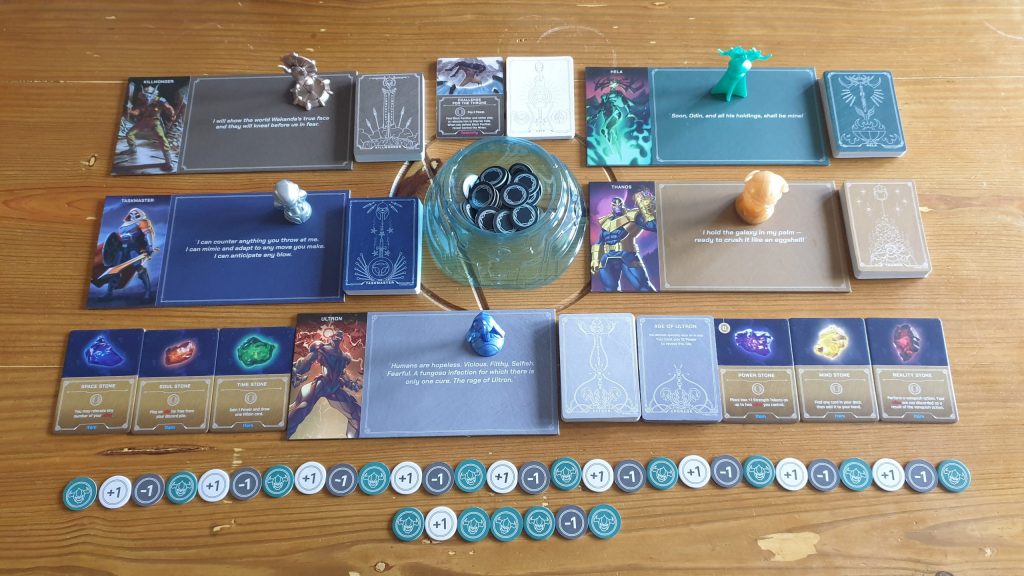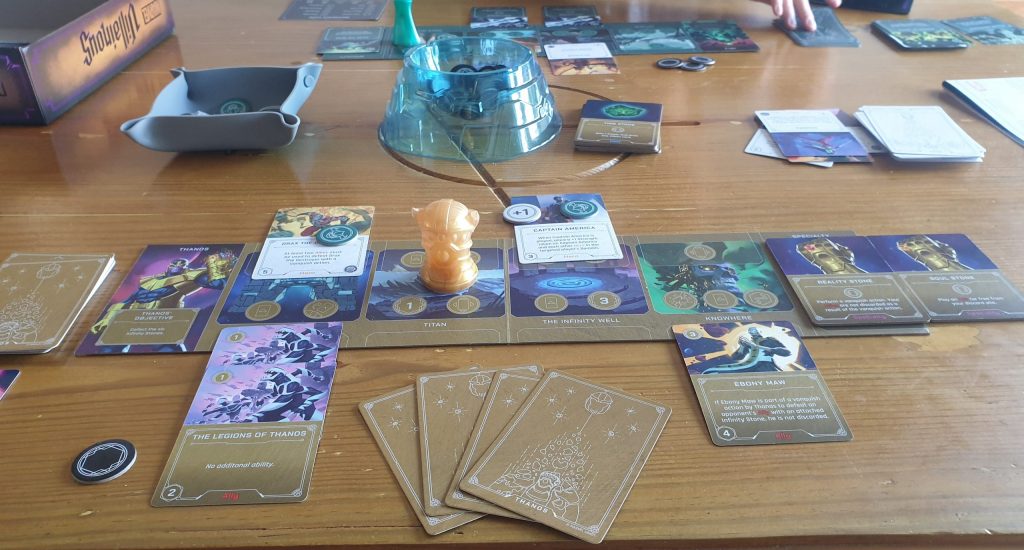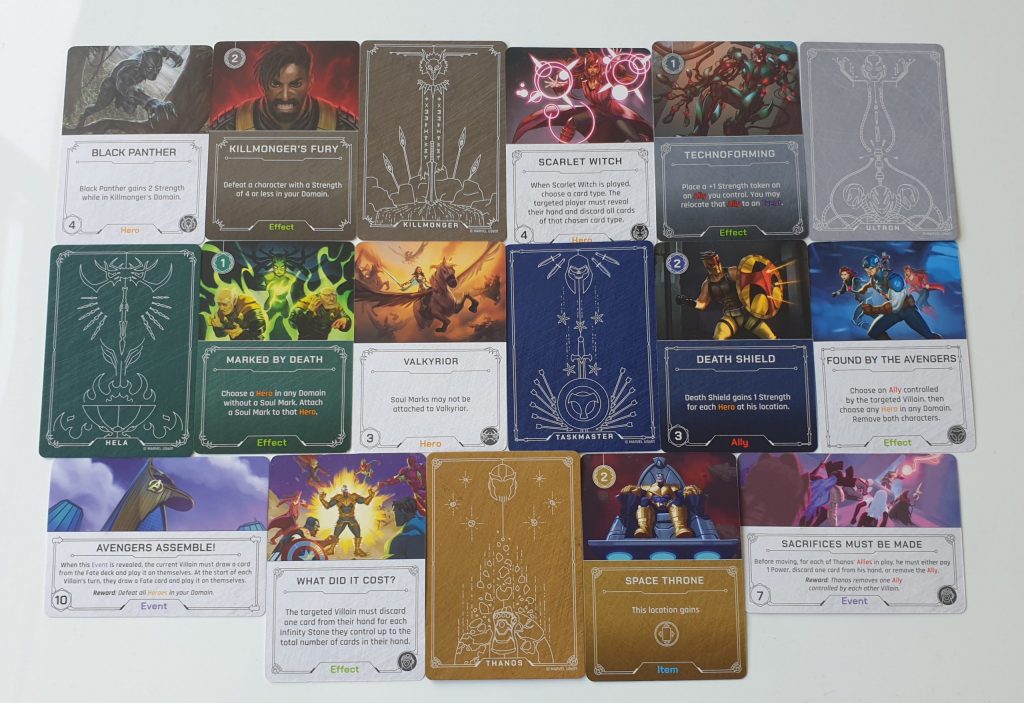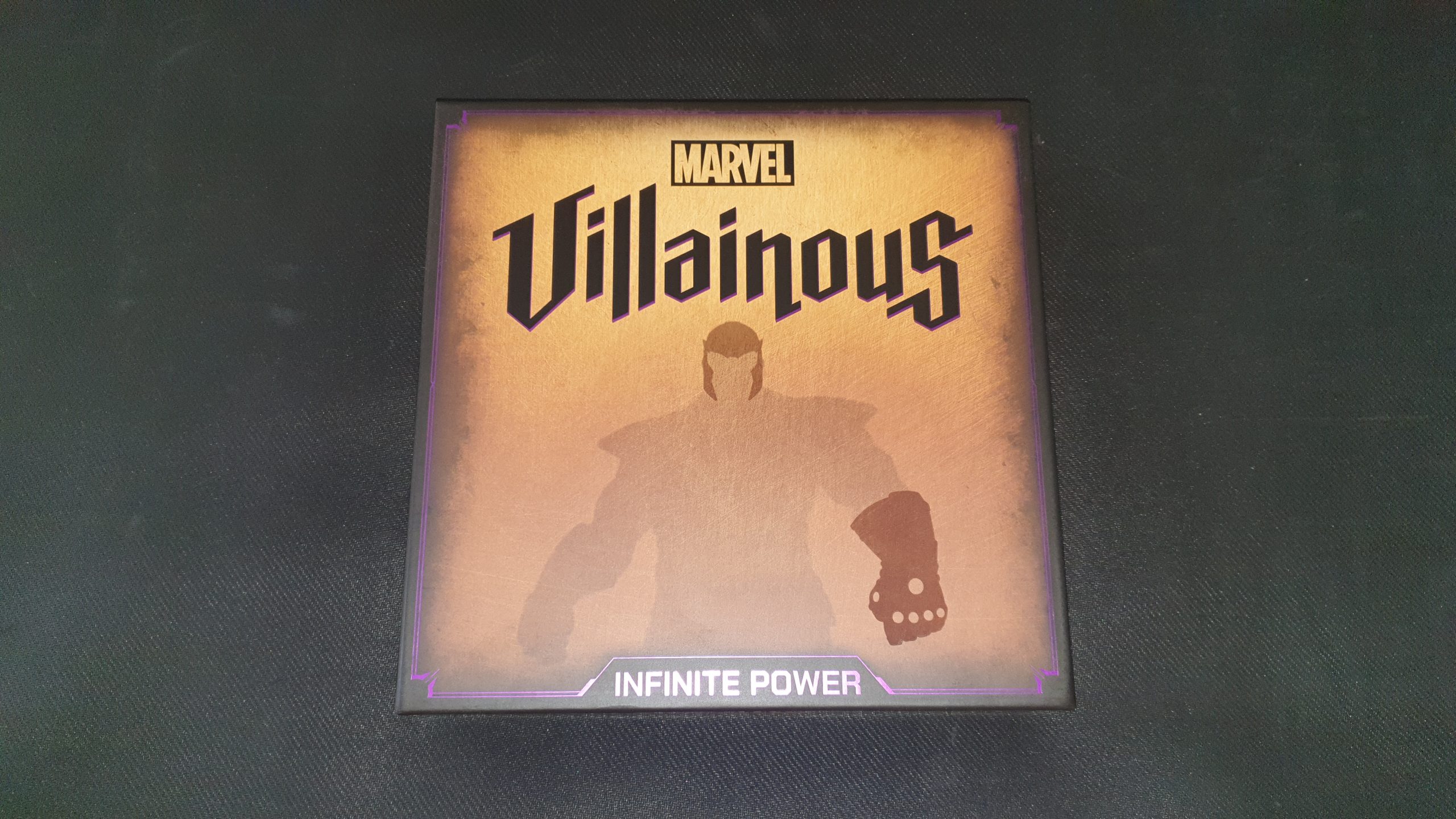Marvel Villainous: Infinite Power is a brand new board game from publisher Ravensburger, featuring unique player powers and objectives. Designed by the team at Prospero Hall, the game sees 2 – 4 players take up the role of Marvel Villains for around an hour. Coming with Thanos, Hela, Ultron, Killmonger and Taskmaster, there is certainly plenty of evil included. The game isn’t quite a direct sequel to Disney Villainous, and it is also not compatible. However, does the Marvel Universe transition well to the Villainous style gameplay? Let’s find out!
Starting off players get to decide which villain they want to be, with no pesky heroes to choose from – unless you see what Thanos did as a good thing… Each has a unique player board, a mover pawn and a set of cards. Some of these cards, with a white back, are fate cards. A general fate deck and those of the in-play villains are combined and shuffled. The remaining cards are the Villain cards, with players having their own decks – which are individually shuffled. Players will draw a hand of 4 starting cards from their villain deck, with some power tokens distributed depending on the play order. Some villains have unique setup elements, such as Hela grabbing the soul mark tokens, otherwise it is time to play!
On a turn players will move their mover pawn to one of the locations on their board. For the first turn this can be to any location, though afterwards must be to a different one. Locations have action symbols on them, denoting what a player can do when going to that location. These range from spending power tokens to play a card from their hand, through vanquishing heroes, to fating opponents. One aspect of the Disney version that hasn’t been brought across (yet) are locked locations, with none featuring on the five character boards. Only a few of the released characters for Disney Villainous used these features though, so perhaps future Marvel releases may bring this back.

The 5 villains each need to use the same actions to achieve different end goals. As soon as any player completes their objective they win. Hela aims to compile her strength by amassing soul marks, in Odin’s Vault, and allies in play. The trick is she doesn’t have to vanquish a marked hero, others can do it for her. Killmonger almost has a locked location – starting with rival Klaw covering actions on the golden city. For Killmonger step one is defeating Klaw before challenging for the throne and activating control the mines. Mines allow Killmonger to send explosives to other players’ domains – which is his victory condition but it can also make it harder for others to defeat heroes at the chosen locations.
Ultron is all about working towards unlocking the age of ultron – his fourth specialty card. Each stage has a prerequisite to meet but then they give ongoing perks – so progress feels like it is truly occuring. Taskmaster has a simple sounding objective of 4 allies with 5 or more strength at different locations. Note that this is regardless of if they are at events or in other players domains. It might sound easy but his highest valued ally is a 3, though there are 4 of these 3s in his deck.
Thanos’ objective is easy to understand, though getting hold of the six infinity stones isn’t that simple. Thanos is all about dipping in and out of other worlds on his hunt for the infinity stones – breaking some of the normal movement rules that the game uses. At two this just feels a bit off as Thanos is constantly sending allies against one villain. Other effects and descriptions are also worded oddly for two player games, making the experience feel like it truly starts with 3 players – but that the game can play with 2.

At times in Disney Villainous we had to quickly jump to the rulebook or the player booklets, to double check something. It may be due to the lack of clarity with how fate decks interact with different objects and players but this seemed to occur at greater amounts in Marvel Villainous and all players had previous experience with the Disney version. With a bit of group agreement, as to what effect something has, the game can progress, but this isn’t ideal. Especially as it could put inexperienced players off. One or two of these have come from elements already noted by one of the publishers as a misprint. The rest of the confusion has revolved around the ways that the cards interact, with limited examples given in the rulebook.
Having one fate deck is simpler in concept. By removing the choice of drawing multiple fate cards at times fates felt impactful and others barely noticeable. The central deck does mean that, as an example, Ultron’s fate cards can be played on Taskmaster – which all makes some sense as it is one big universe. There is a choice when playing with multiple people of whom to target. Alas, it seems more luck based by effectively top decking and having no choice about the card effect. The introduction of events is an interesting one though, adding in a choice for all players whether to work to vanquish it for a reward or work around it. Players can choose how impactful events will be. Choosing not to include them allows for a simpler experience, perfect for learning the game. After this players will want to include them and even try the Undying mode that allows them to build up, rather than only one being active at a time.
The game itself does slightly outstay its welcome, and not only for the normal reasons. The game ends with everyone getting close to their objectives. Getting there can sometimes feel a bit of a plod, with slow building turns before successfully completing part of your overall objective. A speed boost of each player starting with additional power tokens would allow the first few rounds to be more explosive out of the gate. The real issue though is when packing away, with players having to split out the fate deck – which is a slow process. Especially with the full player count, it’s an annoyance that slows the game night from moving on, akin to but worse than having to remove cards from a deck before being able to play.

Production wise Marvel Villainous is solid, though it isn’t as perfect as the Disney Villainous titles. The card quality, the glorious artwork that adorns all of the components and the decent power tokens all remain. The introduction of strength tokens to increase and decrease the strength of characters means one less thing for players to keep track of with cards stacking up across the domains. These tokens are in keeping with the style of the power tokens and match them in quality. It isn’t a deal breaker but the mover pawns for the villains don’t match up quality wise. Their silhouettes are all unique, and via this and their colouring it is easy to distinguish which character they are for. The solid feel to them is gone though, and in the right light you can see they aren’t solid plastic – making the game feel minutely cheaper.
Marvel Villainous is a game that requires multiple plays, not just of it but of the individual characters. Not only do they need to do vastly different things to win, even their fate decks add new twists to the mix. From the get go variety is instilled with what players aim to do and what they can do to others to halt their goals. The production quality isn’t really an issue, being great compared to most games – just not to Disney Villainous. The biggest travesty is that some of the changes, such as the combined Fate deck, stop the Disney and Marvel Villainous games from being combined. Whether it is a licensing problem or something, when playing there is the constant thought of wouldn’t it be amazing to combine the two very similar games to play with all of the villains. Marvel Villainous is a good game. However, when up against so many other Marvel games being released and Disney Villainous, it is only true Marvel fans that should save it a space on their shelf.
(Editor’s Note: Marvel Villainous was provided to us by the publisher for the review. Check out the game on the Ravensburger website here.)

